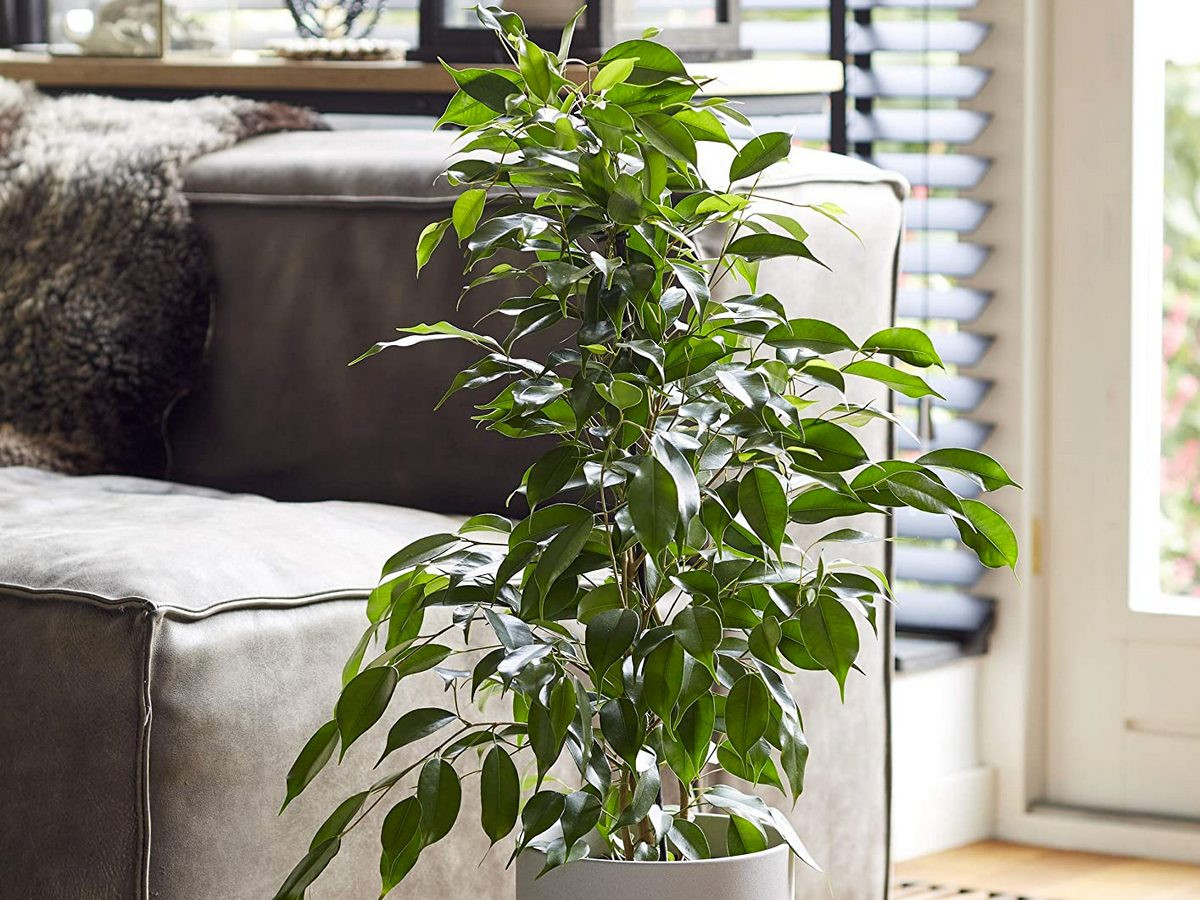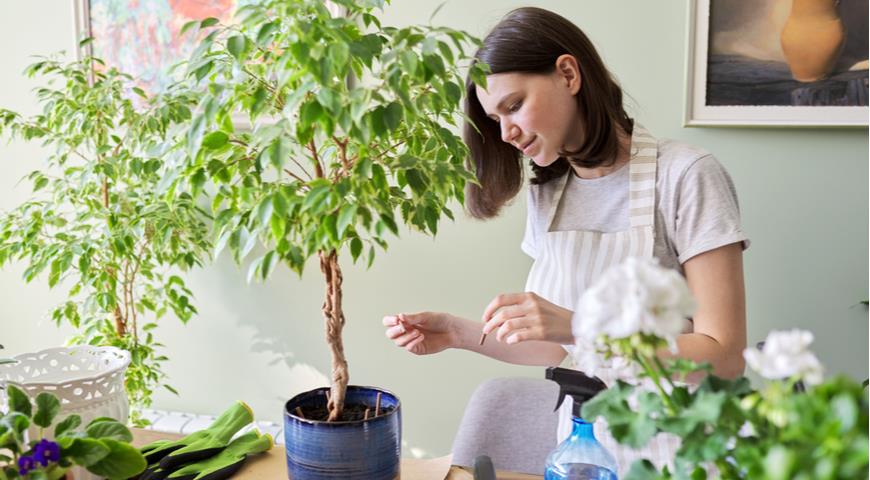- Швидка
доставка - Свіжі
квіти - Вигідні
ціни
Фікус Бенджаміна
Фікус Бенджаміна, також відомий як "Каучукове дерево" або "Дерево свободи", є рослиною сімейства тутових і походить з Азії. Його початкове місце походження – Індія, Непал та Китай. До Європи фікус Бенджаміна був привезений у 1774 році, а до США – у 1820-х роках. Він був дуже популярний серед багатих сімей і використовувався як декоративна рослина в інтер'єрах знатних будинків. Сьогодні фікус Бенджамін є однією з найпопулярніших кімнатних рослин у світі і може досягати висоти до 30 метрів у своїх рідних умовах. У дикій природі його дерева можуть рости дуже довго – до 150-200 років.
Фікус Бенджаміна - це вічнозелене дерево або чагарник, який має щільну крону, що складається з темно-зеленого листя, що блищить на сонці. Листя рослини має еліптичну форму і може бути довжиною від 6 до 13 см, а шириною від 2 до 6 см. Колір листя може бути різним, від темно-зеленого до світло-зеленого, з білими, жовтими, кремовими або сріблястими плямами на краях або центром листка. Деякі сорти мають листя з червоним або бронзовим забарвленням. Доросле дерево фікуса Бенджаміна має гладку, сіро-коричневу кору, яка з часом може почати лущитись. Загалом фікус Бенджаміна має дуже елегантний зовнішній вигляд, який робить його популярною рослиною для прикраси інтер'єрів у будинках та офісах.
Крім того, фікус Бенджаміна має повітряне коріння, яке можна використовувати для створення цікавих композицій та оформлення інтер'єрів. Це коріння може вирости зі стовбура або гілок рослини і досягати значної довжини, що дозволяє використовувати їх для створення різних форм і конструкцій. Також варто відзначити, що фікус Бенджамін є рослиною з дуже високою адаптивністю і може пристосовуватися до різних умов навколишнього середовища. Він може рости як у півтіні, так і на яскравому сонці, і стійкий до коливань температури та вологості повітря.
Догляд за фікусом Бенджаміна
- Освітлення: фікус Бенджаміна віддає перевагу яскравому, але розсіяному освітленню, так що ставте його в місці, де є достатньо світла, але сонячні промені не будуть прямо потрапляти на рослину.
- Полив: фікус Бенджаміна потребує регулярного поливу, але не переносить затоплення. Поливайте рослину тільки тоді, коли верхній шар ґрунту починає висихати і переконайтеся, що вода не залишається в піддоні.
- Вологість: ця рослина також потребує достатньої вологості повітря. Ви можете забезпечити цю вологість шляхом розпилення води на листя рослини або розміщення її поруч із зволожувачем повітря.
- Добрива: фікус Бенджаміна потребує регулярного підживлення. Підживіть його універсальним добривом для кімнатних рослин у період активного росту, який зазвичай припадає на весну та літо.
- Обрізка: щоб зберегти бажану форму крони і сприяти зростанню нових пагонів, необхідно регулярно обрізати фікус Бенджаміна. Обрізайте його під час спокою, коли він не росте так швидко.
- Захист від шкідників: фікус Бенджаміна може бути атакований різними шкідниками, такими як щитівки, попелиця та борошнистий червець. Перевіряйте рослину регулярно і вживайте відповідних заходів, щоб уникнути їх появи та поширення.
Проблеми, пов'язані з вирощуванням фікуса Бенджаміна
Ось деякі поширені проблеми та хвороби, які можуть виникнути у фікуса Бенджаміна, а також поради щодо їх запобігання та лікування:
- Поява жовтого листя: жовтіння листя може бути викликане надлишковим або недостатнім поливом, надто яскравим освітленням або низькою температурою. Переконайтеся, що рослина отримує достатньо світла та води, і що температура в приміщенні не надто низька.
- Падіння листя: падіння листя може бути спричинене нестачею вологи в ґрунті або надмірним поливом, низькою температурою, перепадами температур або зміною умов освітлення. Перевірте, що рослина поливається регулярно і отримує достатню кількість світла та вологи.
- Хлороз: хлороз є захворюванням, при якому листя стає блідим або жовтим через нестачу заліза або інших поживних речовин. Використовуйте добрива для кімнатних рослин, щоб запобігти нестачі поживних речовин.
- Поразка шкідниками: фікус Бенджаміна може бути атакований різними шкідниками, такими як щитівки, попелиця, борошнистий червець або кліщі. Перевіряйте рослину регулярно і вживайте відповідних заходів, щоб уникнути їх появи та поширення.
- Хвороби коренів: хвороби коренів можуть виникнути через надмірне поливання або погану дренажну систему. Переконайтеся, що рослина поливається тільки тоді, коли верхній шар ґрунту висихає, і що у нього достатньо дренажної системи.
- Плямистий листя: плямистість листя може бути викликана різними грибковими або бактеріальними інфекціями. Видаліть уражене листя та обробіть рослину відповідними препаратами для боротьби з інфекцією.
Загалом, щоб запобігти проблемам і хворобам у фікуса Бенджаміна, необхідно стежити за умовами утримання рослини та регулярно проводити огляд рослини на предмет захворювань або шкідників. Деякі додаткові поради щодо догляду за фікусом Бенджаміна:
- Регулярно поливайте рослину, але уникайте надлишкового поливу, що може призвести до гниття коріння.
- Переконайтеся, що рослина отримує достатньо світла, але уникайте прямих променів сонця, які можуть спричинити опіки листя.
- Поступово звикайте рослину до нових умов освітлення або температури, щоб уникнути стресу.
- Регулярно видаляйте пил з листя, щоб запобігти розвитку грибкових інфекцій або ураження шкідниками.
- Проводьте періодичне обрізування рослини, щоб видаляти пошкоджені або старі гілки та зміцнювати форму рослини.
Якщо ви виявили будь-які проблеми з фікус Бенджаміна, зверніться до фахівця з рослинництва, який допоможе визначити причину проблеми і запропонує найбільш ефективні способи лікування.
Розмноження фікуса Бенджаміна
Фікус Бенджаміна можна розмножувати кількома способами, кожен з яких має свої переваги та недоліки. Розглянемо найпоширеніші методи розмноження:
- Розмноження живцями - Цей метод розмноження підходить для отримання точної копії материнської рослини. Для цього необхідно відрізати здоровий і міцний черешок довжиною 10-15 см з кількома листками. Потім зріжте нижнє листя і помістіть живець у склянку з водою або в ґрунт. Через кілька тижнів коріння почне рости, а потім можна пересадити живець у грунт.
- Розмноження за допомогою повітряного коріння - Фікус Бенджаміна може утворювати повітряне коріння, яке можна використовувати для розмноження рослини. Для цього виберіть здорову та міцну гілку та надріжте її кору. Потім оберніть мокру сфагнову мохову кульку навколо пошкодженого місця та закріпіть її плівкою. Через кілька тижнів коріння почне рости в моховій кульці. Потім можна відрізати гілку вище кульки і пересадити її в ґрунт.
- Розмноження листовими живцями - Для цього методу виберіть здоровий та міцний лист і відріжте його з невеликою частиною стебла. Потім помістіть листовий живець у воду або ґрунт і тримайте його в теплому та вологому місці. За кілька тижнів почнуть рости нові рослини з нирок на стеблі.
- Розмноження насінням - Цей метод розмноження найскладніший і потребує певних навичок. Насіння фікуса Бенджаміна можна купити в магазинах або отримати від дозрілого плоду. Потім посадіть насіння в ґрунт і тримайте його в теплому та вологому місці. За кілька тижнів почнуть рости нові рослини.
Вибір найбільш відповідного методу розмноження залежить від вашого досвіду та бажаного результату. Якщо ви хочете отримати точну копію материнської рослини, виберіть метод розмноження живцями або повітряним корінням. Якщо ви хочете експериментувати з генетичними характеристиками рослини, то краще використовувати розмноження насінням. Якщо ж ви хочете отримати більше рослин з одного, то розмноження листовими живцями може бути найефективнішим методом. Незалежно від обраного методу розмноження, важливо дотримуватися правил догляду за новими рослинами, щоб вони могли добре укорінитися і розвиватися. Визначте оптимальні умови для кожного методу, такі як температура, вологість та освітлення, та переконайтеся, що нові рослини отримують достатньо живлення та вологи. Крім того, не забувайте пересаджувати нові рослини у правильний ґрунт та контролювати наявність шкідників та хвороб.
Декоративне використання фікуса Бенджаміна
Фікус Бенджамін - одна з найбільш популярних рослин для декоративного використання в приміщеннях. Його красиве листя і здатність рости у вигляді великого дерева роблять його чудовим вибором для прикраси будинку чи офісу. Фікус Бенджаміна може використовуватися як одиночна рослина або в поєднанні з іншими рослинами в композиціях. Його листя буває різної форми та розміру, від круглих до овальних та ланцетних, із зубчастими або гладкими краями, що дозволяє створювати різноманітні композиції. Крім того, фікус Бенджаміна може бути використаний як рослина для озеленення приміщень. Його здатність до очищення повітря від шкідливих речовин, таких як формальдегід, бензол і трихлоретилен робить його ідеальним для використання в приміщеннях з низькою якістю повітря. Фікус Бенджаміна також може бути використаний як рослина для створення тіньових куточків. Завдяки його здатності до швидкого зростання і високої густоти листя він може створити приємну тінь і створити затишну атмосферу в кімнаті.
Також важливо правильно підібрати контейнер для рослини. Контейнери можуть бути виготовлені з різних матеріалів, таких як глина, пластик, метал та дерево. Глиняні контейнери зазвичай вважаються найбільш підходящими, оскільки вони забезпечують хорошу вентиляцію та дренаж. Крім того, глиняні контейнери можуть допомогти керувати рівнем вологості ґрунту, що особливо корисно для фікуса Бенджаміна.
Важливо також враховувати сусідство рослин. Фікус Бенджаміна можна вирощувати як самостійну рослину, так і у поєднанні з іншими рослинами. Якщо ви вирішили використати фікус Бенджаміна в композиції, вибирайте рослини, які можуть витримувати умови, необхідні для зростання фікуса Бенджаміна. Деякі рослини, які можуть добре поєднуватися з фікус Бенджаміна, включають жасмин, пальми, аспарагус, лілії і бамбук.
Нарешті, не забувайте вибирати контейнер та компаньйонів відповідно до загального стилю декору вашого будинку чи офісу. Фікус Бенджамін може бути відмінним елементом дизайну, який може доповнити загальну атмосферу вашого простору.

